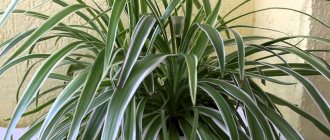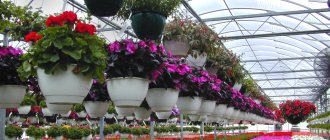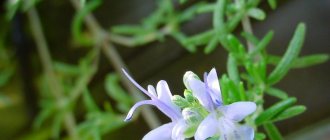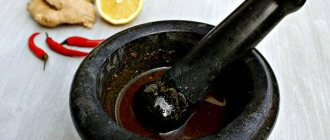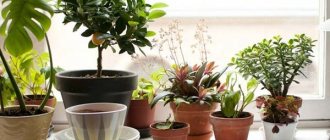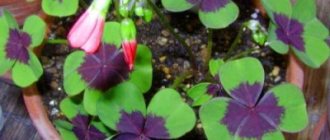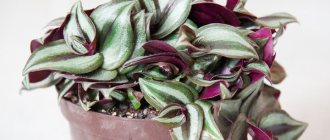Low-maintenance flowers are a real boon for housewives. This is especially true for those who often go on business trips or vacations. Such plants will also become a real decoration for offices, country houses, and shops. What are the most popular crops in the world can be found in this article.
On this topic:
A luxurious flower for your flowerpot and more -...
Aug 28, 2020
Large-sized Tradescantia or reo flower - care for...
Aug 28, 2020
Large-sized palm tree for a spacious hall - areca, care in...
Aug 27, 2020
“Live” flower on your window - oxalis, care...
Aug 21, 2020
BACK FORWARD 1 of 74
Flowers that do not require frequent watering
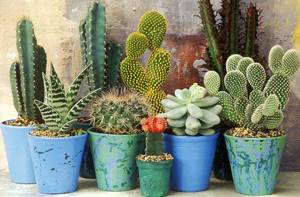
From this category, cacti are the first to come to mind. These house plants are the easiest to care for. They really don’t require a lot of water, but during the flowering period they truly delight their owners. There are so many varieties of cacti that you can collect a whole collection.
Another group of flowers that do not require frequent watering are succulents. They have thick, fleshy leaves in which they accumulate moisture. Such indoor plants do not tolerate overflows or stagnant water, so you can leave them without worrying. The most popular among them are “money tree”, aloe, and Kalanchoe.
Lithops are also classified as succulents. They are also called living stones. In addition to infrequent watering (in winter you don’t have to water them at all), they have another advantage: they do not take up much space.
Flowers that are not afraid of drafts
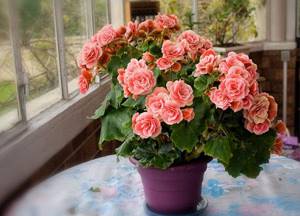
The kitchen is a place that requires constantly open windows or vents. Not all indoor plants survive in such conditions. Therefore, it is best to decorate the kitchen with flowers that are not afraid of drafts.
On this topic:
The longest flowering indoor plant is lantana, care...
Aug 9, 2020
Ficus benjamina - leaves are falling, what to do with this...
Jul 19, 2020
BACK FORWARD 1 of 143
These include:
- aloe and kalanchoe, they are useful in the kitchen in case of a cut or burn, as well as for other medical and cosmetic purposes;
- begonia;
- hoya;
- phalaenopsis orchid;
- indoor myrtle;
- chlorophytum (it purifies the air well).
Houseplants that don't require light
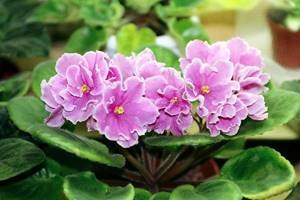
Another problem for flower lovers is lighting, since most indoor plants prefer sunlight. But despite this, I want to plant trees in both darkened rooms and areas of the apartment. For such purposes, it is necessary to choose home plants that do not require light.
Without access to sunlight or special lighting using lamps, not a single flower can survive. But with minimal light, shade-tolerant plants will delight with beautiful green foliage, some with bright buds.
Of the flowering specimens suitable for growing in the shade:
- anthurium;
- clivia;
- vriesia;
- Saintpaulia or violet;
- mother-in-law's tongue or sansevieria;
- all types of ferns;
- dracaena;
- monstera;
- various types of palm trees (hamedorea, rapis and others).
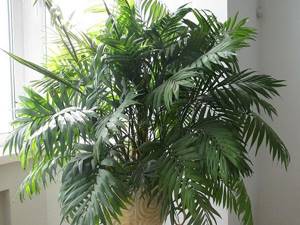
For all indoor flowers that do not require special care, it is with moderate lighting that the most beautiful leaf colors appear.
When exposed to direct sunlight, on the contrary, they become very pale. Often these crops require high humidity (spraying) and do not like transplanting.
Shade-loving indoor plants
Lighting is critical to the life of indoor plants. Light is necessary for the process of photosynthesis, as a result of which plants synthesize organic substances for their growth and vital activity. Different types of plants need different amounts of light.
There are very photophilous species that require direct sunlight. Most indoor species grow well in bright, indirect light. But there are home flowers that love shade. They are convenient to grow in poorly lit apartments with windows facing north.
Home decorative foliage flowers that love shade
It is often difficult to maintain light-loving plants in houses and apartments due to insufficient natural light. But this does not mean that you need to give up indoor flowers altogether.
There are many house flowers that do not like light, and feel great in darkened rooms where the sun's rays do not penetrate at all. And some flowers are contraindicated in the sun - they develop correctly only in the shade.
Consider shade-loving indoor flowers with their names and photos.
Dieffenbachia
This large indoor plant grows equally well in bright, indirect light and in partial shade. In the shade it may weaken and begin to stretch out. It has a straight trunk that rarely branches. In indoor culture it grows up to 2 m in height. The leaf blades are large, oval, variegated, up to 50 cm long. Used for landscaping spacious rooms.
Ferns
All types of indoor ferns are shade-tolerant plants. In the wild, they have adapted to living in the lower tiers of the forest.
Long and lush fronds of ferns have a bizarre and very decorative shape. These species are grown on hangings or shelves. In cultivation, ferns are kept in partial shade.
With more intense lighting, their foliage loses brightness and fades. In direct sun, delicate ferns can get burned.
Ivy
A herbaceous vine popular in indoor culture. Ivy vines reach several meters in length and have weak branches. New shoots are formed in the lower part near the surface of the earth or from the root. The branches are capable of growing to supports, so common ivy is grown as a hanging plant and is also used for vertical gardening.
The leaves are shiny and leathery. Numerous decorative varieties of this plant are distinguished by variegated two-color and even three-color leaf blades. Ivy grows well in the shade and suffers from direct sunlight. Variegated forms require slightly more intense lighting. They can be kept in partial shade.
Ficus benjamina
A versatile houseplant that grows well in almost any climate. Withstands dryness and abundant watering, heat and cold, direct sun and shade.
Ficus benjamina is a tree-like plant with a straight trunk with light bark, a branched crown with many small leathery leaves.
All its varieties grow well in partial shade, but variegated forms lose color and grow green foliage.
Fittonia
Herbaceous plant of the humid tropics. Needs shading from direct sunlight. Withstands both bright diffused light and partial shade. The height of Fittonia is no more than 50 cm; there are also more compact, low-growing forms.
The leaves of the plant are very diverse in color. Different varieties look great in group planting. Fittonia is a rather demanding species, as it requires intensive watering and high air humidity. Ideal for florarium.
Indoor decorative flowers that do not like light
Usually, with a lack of light, indoor ornamental flowering plants do not form flowers or bloom very sparingly. However, there are also flowering species that can be grown on northern windows in partial shade.
Shade-tolerant ornamental flowering plants are perfectly adapted to such conditions; they bloom profusely and for a long time even in very low light, and the sun's rays can be destructive for them. Below are homemade flowers that love shade in the apartment.
Begonia decorative flowering
Flowering begonias can be grown on northern windowsills. Unlike decorative foliage species, which stretch without sunlight, flowering begonias do not need bright light. They should not be placed in the sun, as they will quickly burn their tender leaves.
There are several types of flowering begonias. These are low plants with succulent leaves of green or reddish shades. They bloom profusely and for a long time. Their flowers come in regular, semi-double and double forms, depending on the variety. The shades of the petals are very diverse - from white and light pink to dark red and burgundy. There are also plants with yellow flowering.
Oxalis
Oxalis or wood sorrel are indoor flowers that love shade. It has many leaves on long petioles growing from a modified and greatly shortened stem.
Indoor oxalis can have green, burgundy and variegated leaf blades. It blooms with small single or collected flowers in inflorescences. There can be several dozen of them on one plant. Prefers partial shade, but can also grow in the shade. Direct sun is harmful to the flower.
Saintpaulia
Saintpaulias or violets are indoor flowers that do not like light and do not need bright lighting. Forms a dense rosette of pubescent dark green leaves. There are variegated varieties of Saintpaulias. Blooms profusely from early spring to late autumn. Flowers are single or collected in inflorescences of 2-3 pieces.
Color - from white to dark blue and burgundy. Numerous varieties of Saintpaulias are distinguished by large double and semi-double flowers. Grows well on northern and north-eastern windows, where there is never direct sun.
Spathiphyllum
Spathiphyllum is another indoor flower that loves shade in the apartment. Very popular due to its unusually shaped flowers. In addition, this plant does not need bright lighting, so it decorates the windowsills of northern windows. All this has made it a favorite plant of many gardeners.
The plant forms lush bushes of dark green leaves, above which white flowers rise on long stalks. The flower is unpretentious; with regular watering and spraying it pleases with regular flowering.
Cyclamen
Cyclamen or alpine violet is a perennial tuberous plant famous for its long and beautiful flowering. Variegated leaves on long petioles grow directly from the tuber. Flowers with long petals have an unusual shape.
Cyclamen prefers northern and northeastern windows. Blooms in winter. During flowering, it is advisable to place these plants on the coldest windowsills away from heating radiators.
Other shade-tolerant plants
In addition to decorative foliage and flowering plants, there are many other varieties of house flowers that do not like light. For landscaping a darkened apartment, it is easy to choose shade-tolerant succulents, orchids and even fruit-bearing species.
Succulents
Succulents grow in dry and hot areas where there is always plenty of sunlight. However, some of them grow well even in partial shade, especially if they are grown in these conditions for a long time. Forest cacti are also succulents.
They have adapted to grow under the cover of large trees, so they do not need bright lighting. The most common shade-tolerant succulents are:
- Sansevieria;
- Haworthia rigidifolia;
- Peperomia;
- Decembrist.
Sansevieria Haworthia rigidifolia Peperomia Decembrist
Orchids
All types of orchids are shade-tolerant plants. These are plants of the humid tropics, where they grow on the bark of tall trees and do not see direct sun. Some of their types require more intense lighting.
But there are also those that can be grown even with weak electric light. These are some species of precious terrestrial orchids. The most famous of them: Makodes and Anectochilus.
Makodes Makodes Anectochilus Anectochilus
These plants require very high humidity. They are usually kept in orchidariums away from windows in artificial light. The phalaenopsis orchid is also quite shade-tolerant, but not at all as demanding as its precious relatives. It does not tolerate direct sunlight, but can develop and bloom well in diffused light and in partial shade.
Ten low-maintenance flowers
To decorate your home with living greenery, but without spending a lot of effort on care, you should pay attention to some types of flowers.
Aloe, aka agave
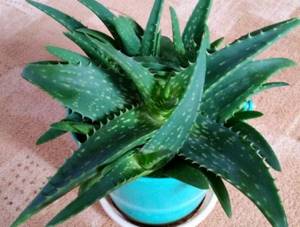
It grows as a small tree and has succulent, fleshy leaves with spines of pale green or even bluish color. It is not necessary to start a classic version; you can choose more decorative varieties with bright colors. For example, aloe tiger or spinous. This is the most unpretentious indoor plant that cleanses the air well from substances emitted by furniture and plastic. It is used in cosmetology and medicine.
Aspidistra, aka "shoemaker's palm"
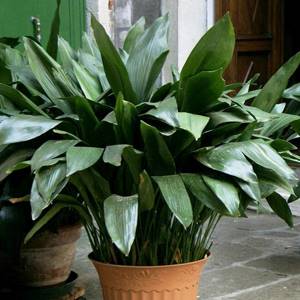
Most often it has simple dark green leaves, but there are decorative species that have white or yellow stripes on the plates. It easily tolerates rooms where there is a lot of dust and little light, and can withstand irregular watering. But it’s not worth replanting, much less transfusing, the aspidistra.
Zamiakulkas or dollar tree
On this topic:
How to grow cucumbers at home in winter and provide for your family...
Delicate, unpretentious “water bread” of soleirolia, care in…
The best balcony flowers for the sunny side
Light, coolness and a mandatory period of rest - it’s all about...
BACK FORWARD 1 of 73
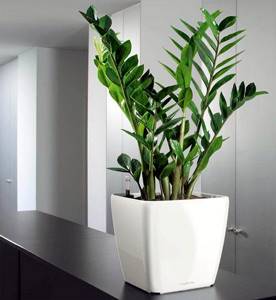
Thick stems, glossy leaves and significant size make this plant a favorite when decorating office spaces. It does not require a lot of light and spraying, suitable for those who rarely remember to water. Does not like replanting or overwatering. This crop has large tubers that are prone to rapid rotting. The less you touch the zamiakulkas, the better it is.
Money tree (crassula)
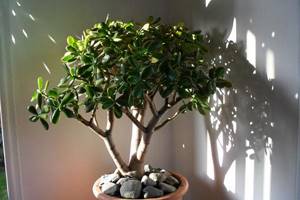
Another symbol of financial stability among flower growers. It should be replanted no more than once every three years. The plant tolerates dry soil well due to its fleshy leaves. The main thing is that the water does not stagnate in the pan.
Nephrolepis or fern
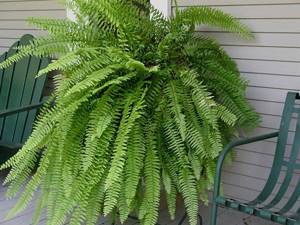
It is valuable because it can be hung at any height and thus add greenery to the room. It grows in dark places, but likes regular watering and frequent spraying.
Scindapsus
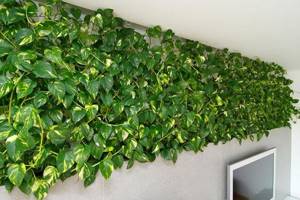
Scindapsus belongs to the lianas. It grows quickly and includes many species with foliage of different colors. Thanks to its aerial roots, it entwines any support. To get a bushier version of the plant, it is better to plant several sprouts in one pot. It is shade-tolerant and can grow well under artificial light. Loves abundant watering. It is useful because it cleans the room air from dust.
Tradescantia
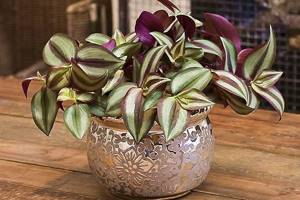
Thanks to its decorative foliage in both green and purple shades, this plant is loved in all rooms. Tradescantia is not afraid of dry air and shade, but it loves regular watering. The plant must be systematically renewed, since the stems of Tradescantia quickly stretch out. Boring plants take root instantly, so propagating the flower will not be difficult.
Cissus or birch
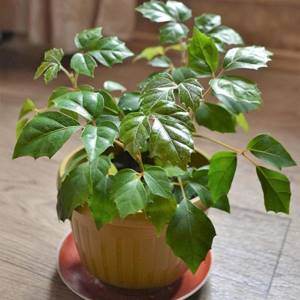
This flower is very easy to care for. It can be found both in apartments and in offices. Grows quickly, branches well. The vine entwines itself with any support and walls. Prefers warm rooms, but is undemanding to light. Tolerates drafts and even cigarette smoke. Cleans the air well.
Chlorophytum
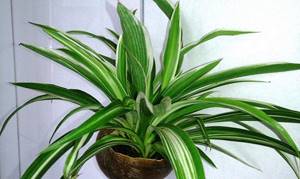
Even novice gardeners can grow it. Grows both in the shade and in diffuse sunlight. This is a very useful crop, which is practically a filter that removes hazardous substances from the air. Tolerates overwatering, drought, cold, drafts and heat. It quickly sprouts sprouts that take root easily.
Sansevieria
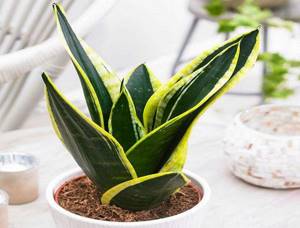
Popularly nicknamed mother-in-law's tongue for the specific shape of its leaves. Can live without watering for up to two weeks. Tolerates both low and high temperatures. Undemanding to lighting. You can rarely replant, once every few years, when the plant does not fit into the pot at all.
Caring for Houseplants in Low Light
It is necessary to take into account the individual characteristics of plants. The ornamental and beautifully flowering plants listed above have one thing in common - they can grow in low light. But their watering conditions, temperature conditions and humidity needs may vary. So, aglaonema loves warmth and humid air (most likely, it will have to be sprayed periodically), but sansevieria is incredibly unpretentious - it tolerates dry air and rare watering, it is not afraid of drafts - an ideal plant for the corridor.
Additional lighting
In rooms where it is completely dark, not a single plant will be able to grow normally, much less bloom. Moreover, in order for an indoor flower to be guaranteed to please you with its blooming, it is better to use additional lighting in the dimness of the corridor. You can make lamps for this yourself. Choose a suitable location and securely secure it above the plants. Or purchase special phytolamps that will provide the necessary light (both in quality and quantity). In addition, they look beautiful, and therefore will only decorate the interior of the corridor.
Indoor unpretentious flowers
Do not think that all flowering indoor plants are necessarily very capricious. There are also those that will delight their owners when kept in rather harsh conditions.
List of homemade unpretentious flowers in pots:
- Spathiphyllum. It grows even in places with artificial lighting, but for more luxuriant flowering it is better to provide access to diffused light. Loves high humidity and spraying. In such conditions, it pleases its owners with beautiful white flowers that do not fall off for a long time.
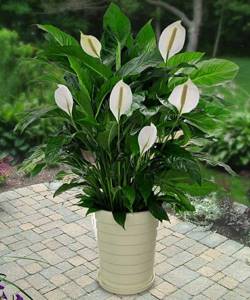
- Hoya. This unpretentious indoor flower has fairly dense leaves, which help the plant to survive without frequent watering. It develops well without fertilizing and tolerates dark places. If the flower has dried up, you can cut off the stem almost at the base, it will sprout new shoots.
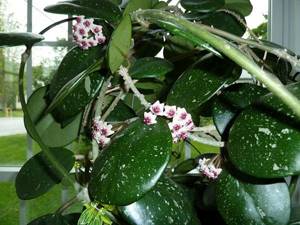
- Kalanchoe. The medicinal species of this plant have their own value, and the flowering varieties delight with abundant and long-lasting flowering. There are varieties with buds of a wide variety of colors. The leaves are succulent, so frequent watering is contraindicated. Can grow in the shade and tolerate temperature changes.
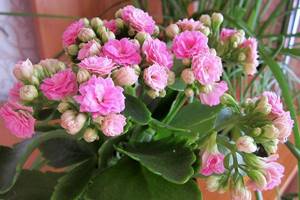
- Geranium is a frequent visitor to window sills. This is an indoor flower for the lazy. Beautiful buds of various shades delight their owners for a long time. Can be kept both in an apartment and on balconies during the warm season. Watering is needed rare but plentiful. Light is important for geraniums; otherwise the culture is undemanding.
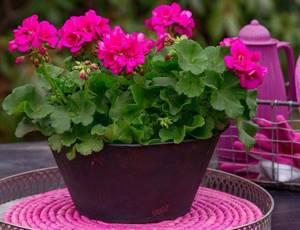
- Fuchsia is another profusely flowering indoor plant that does not require special conditions. In winter, it prefers a dormant period and sheds its leaves, so it does not need frequent watering. In summer, the flowering pot can be moved to the balcony.
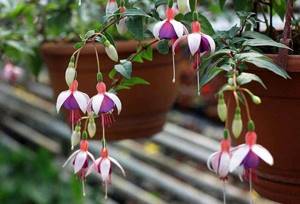
- Clivia. This shade-tolerant and unpretentious plant blooms with beautiful, bell-like flowers. They are arranged in clusters on a high arrow. Does not require frequent watering, periodically sprouts shoots from the roots.

Choose easy-to-care home flowers based on your capabilities and conditions. Let them delight you with bright foliage and lush flowering.
Are there any indoor flowers that love the sun and are not afraid of direct sunlight?
Proper placement of indoor flowers is an important issue for gardeners. Its beauty and vitality directly depend on the amount of sun that a crop receives. Some plants prefer shade, while others, on the contrary, need increased lighting for normal growth.
Names of sun-loving indoor plants with photos
According to flower growers, indoor crops must be shaded to protect them from sunlight. For this reason, the home collection is placed in one optimally lit place. South windows that provide bright sunlight are most often empty.
However, there are many varieties for which the sun does not interfere with their successful development and, moreover, is vital. It gives the plant energy resources to form the decorative qualities of the flower. Placed in the shade, such specimens gradually lose their inherent characteristics, turning into weak, not very attractive crops.
Some indoor exotics were brought from tropical countries, where the sun shines much more intensely than in the middle zone. Accordingly, they require a lot of sunlight.
However, when choosing a location for a flower garden, you should take into account the time of year and the intensity of the sun inherent in the region. Sunlight in Baku and St. Petersburg is different.
And if a flower placed on a sunny window in a St. Petersburg apartment feels great, then in Baku on the south side it will receive serious burns.
Reference! When sunlight passes through window glass, the likelihood of getting burned increases.
The time of year greatly affects the intensity of light. In winter and autumn, southern windows are the only place where exotic plants receive the required amount of light. Even if it is shade-loving and required shading in the summer.
When choosing a place for sun-loving crops, take into account:
- region of residence;
- intensity of sunlight;
- season;
- features of the species.
For south windows
When placing exotics on southern windows, it is important not to forget that natives of the tropics, who love bright sunlight, are now presented in the form of hybrids. These varieties are more delicate and are not able to tolerate the tropical climate familiar to their ancestors.
Watering and spraying crops located on the sunny side are also important. The soil in the pot dries out quickly under such conditions, which negatively affects the health of the exotic plant. After spraying, drops of water remain on the surface of the leaves. During the day, they lead to burns, as they act as a lens for the sun's rays.
However, there are many plants that require sunlight for normal development and flowering. These include:
- almost all types of cacti;
- succulent plants;
- flowers that cannot tolerate waterlogging.
Abutilon, or indoor maple, is suitable for placement on southern windows. It has wide leaves and forms graceful inflorescences consisting of flowers of a rich blue-blue hue.
Certain varieties of hibiscus develop well on the south side. For their flowers to form, elevated temperatures and bright lighting are considered mandatory.
Geraniums are unable to form buds without plenty of light. The longer the daylight hours, the more active the flowering. Anthurium is able to develop and bloom only on southern windows. Placing the plant on the northern or eastern sides leads to its death.
Types that can be placed on south-facing windows include:
- agapanthus;
- chlorophytum;
- codiaum;
- fuchsia;
- balsam;
- aloe;
- Kalanchoe;
- Cattleya;
- jasmine;
- passionflower.
Not afraid of direct rays
Some gardeners advise shading all plants, citing the risk of burns on the leaves. However, there are crops that are not afraid of sunlight and are able to grow and bloom profusely in these conditions.
The only limitation is the mandatory gradual adaptation to lighting. If the exotic plant previously lived in conditions of lack of light, then moving it to the south side causes burns on the leaves.
In such situations, the plant must first be shaded to give it time to adapt.
Common representatives of plants that are not afraid of the sun's rays are cacti. In addition, bright sun stimulates their flowering. It is better to place arrowroot and all types of flowers with variegated leaf colors on southern windows for the winter, since in other conditions they suffer from a lack of light and lose their decorative coloring.
Need sun rays:
- Hoya;
- Stephanotis;
- Clivia;
- Sparmania;
- Campanula equifolia;
- Cyperus;
- Trachycarpus.
Easily tolerate indoor heat
Some indoor plants were exported from hot countries, so high temperatures will not interfere with their development. If you combine warmth in the room with regular spraying and placing it in a tray with wet expanded clay, then the conditions for tropical exotics will be closer to ideal.
For example, violet feels normal in a warm room filled with light. Thanks to such conditions, it pleases the owner with bright colors. The perennial bulbous plant hippeastrum produces unusual and large flowers only in hot climates.
High temperatures are easily tolerated:
- Crassula;
- Lithops (living stones);
- Chlorophytum.
Reference! If the temperature in the room is elevated, it is important to provide the plant with additional watering and spraying.
Cacti and lithops are considered the undoubted leaders in terms of resistance to sunlight. They are able to develop in hot climates, do not suffer from bright light, and calmly tolerate periods of drought.
In terms of endurance and resistance to negative external factors, only aloe and “mother-in-law’s tongue” are compared with cacti.
These plants are able to calmly tolerate sunlight and heat, sudden drops in temperature, lack of moisture and drafts.
Reference! Plants that require large amounts of sunlight are called heliophytes.
Signs of sun-tolerant flowers:
- narrow, symmetrical leaves;
- on the surface of the leaf blade there is often a slight pubescence, which acts as protection against burns;
- short shoots.
Features of growing flowers that love the sun
It is best to plant such flowers in ceramic pots. This container has improved air exchange and moisture evaporates faster. During evaporation, the soil temperature decreases significantly, which protects the roots from overheating and rotting.
Pots in which sun-loving crops are planted should be light in color. Dark color attracts sunlight and leads to overheating of the soil. The temperature on the windowsill of a south-facing window in summer can reach 40 degrees, and this should be taken into account when placing flowers on it. It is also not recommended to expose crops planted in a transparent flowerpot to the open sun.
Reference! If a plant looks lethargic and sick when grown on a windowsill, you should place it on a side table a little further from the window.
When caring for sun-loving plants, you should follow the following basic rules:
- provide the right amount of light;
- accustom to the sun (gradually);
- observe the irrigation regime;
- choose a suitable flowerpot.
Watering on the sunny side
When growing flowers on southern windows, you should remember the rapid evaporation of moisture from exposure to bright sunlight. Such crops require more frequent watering and spraying. It is better to spray flowers in the evening. This will prevent burns from occurring where water droplets have accumulated on the leaves.
It would be a good idea to place the pots on pallets with wet expanded clay. This will help maintain comfortable air humidity around the greenery.
Some types of flowers do not tolerate excess moisture. This should be taken into account when growing. For such crops, it is better to use soaking rather than root watering. This way the soil will absorb only the required amount of moisture.
Reference! Flower pots should have drainage holes to remove excess water.
To ensure the normal development of culture, you should follow simple rules:
- water the flower taking into account its characteristics;
- do not overwater succulents;
- do not allow the earthen clod to dry out too much;
- ensure regular spraying.
Do they like fertilizers?
When growing any flower, fertilizers must be added to the soil. Regardless of whether the variety is shade-loving or prefers bright light, it needs useful elements for nutrition. Otherwise, the flower will not have enough building material to form new shoots and inflorescences.
New soil after transplantation is depleted in about 2-3 months. Accordingly, fertilizer will be required.
The plant is fed depending on the time of year and the characteristics of the variety:
- in spring and summer - monthly;
- in autumn - 1-2 times per season;
- In winter, you can refrain from fertilizing.
Most house flowers hibernate in winter, stop growing and do not need feeding. If the plant blooms in winter or late autumn, it is necessary to continue fertilizing.
There are many flowers that can successfully grow and form buds without fear of sunlight. Some varieties bloom only in ample light. Such crops will be uncomfortable in the shade or in the back of the room.
In winter, when there is very little sunlight, less resistant plants can be moved to southern windows.
Source: https://ufermer.com/komnatnye-rasteniya/kotorye-ljubjat-solnce.html
